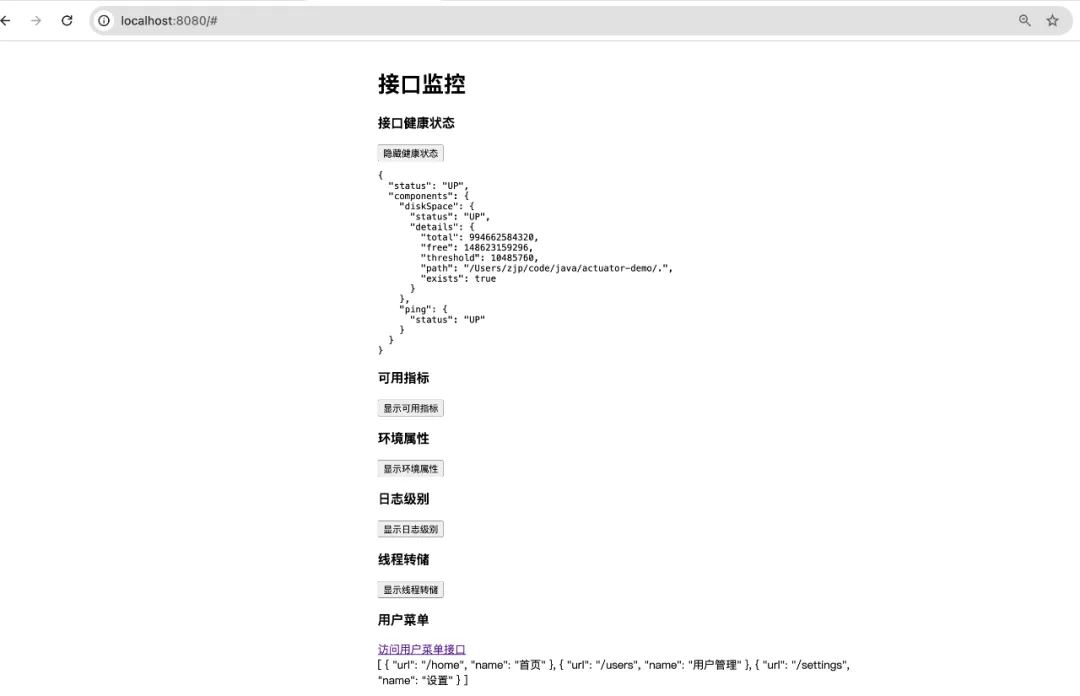在现代应用开发中,系统的实时监控和维护变得至关重要。Spring Boot 3.3 的 Actuator 模块为开发者提供了一整套强大的监控功能,使得应用程序的健康状况、性能指标、用户行为及安全性得以全方位掌握和管理。本文将详细介绍如何配置和使用 Actuator,并展示如何将这些监控数据在前端页面中可视化。
Spring Boot 3.3 的 Actuator 模块提供了一整套全面的监控功能,帮助开发者更好地管理和维护应用程序。主要功能包括:
- 健康检查:实时监控应用的健康状态,快速发现和处理系统问题,确保应用稳定运行。
- 性能指标:监控应用的性能数据,如请求处理时间和响应时间,帮助识别和解决性能瓶颈。
- 环境属性:展示应用的环境配置信息,为调试和环境管理提供支持。
- 请求追踪:记录和分析 HTTP 请求的详细信息,帮助追踪和定位问题源头。
- 日志管理:动态调整日志级别,方便进行问题排查和监控。
- 线程转储:提供 JVM 线程的详细转储信息,帮助分析线程状态和优化性能。
这些功能使得开发者能够实时获取应用的运行状态,优化系统性能,提升用户体验,并增强系统的安全性。接下来,我们将展示如何配置 Actuator 及其功能,并如何在前端页面中展示这些监控数据。
运行效果:
 图片
图片
若想获取项目完整代码以及其他文章的项目源码,且在代码编写时遇到问题需要咨询交流,欢迎加入下方的知识星球。
项目依赖配置
首先,确保你的 pom.xml 文件中包含 Actuator 和 Thymeleaf 的依赖。
<?xml versinotallow="1.0" encoding="UTF-8"?>
<project xmlns="http://maven.apache.org/POM/4.0.0" xmlns:xsi="http://www.w3.org/2001/XMLSchema-instance"
xsi:schemaLocation="http://maven.apache.org/POM/4.0.0 https://maven.apache.org/xsd/maven-4.0.0.xsd">
<modelVersion>4.0.0</modelVersion>
<parent>
<groupId>org.springframework.boot</groupId>
<artifactId>spring-boot-starter-parent</artifactId>
<version>3.3.3</version>
<relativePath/> <!-- lookup parent from repository -->
</parent>
<groupId>com.icoderoad</groupId>
<artifactId>actuator-demo</artifactId>
<version>0.0.1-SNAPSHOT</version>
<name>actuator-demo</name>
<description>Demo project for Spring Boot</description>
<properties>
<java.version>17</java.version>
</properties>
<dependencies>
<!-- Spring Boot Starter Web -->
<dependency>
<groupId>org.springframework.boot</groupId>
<artifactId>spring-boot-starter-web</artifactId>
</dependency>
<!-- Spring Boot Actuator -->
<dependency>
<groupId>org.springframework.boot</groupId>
<artifactId>spring-boot-starter-actuator</artifactId>
</dependency>
<!-- Thymeleaf for HTML templates -->
<dependency>
<groupId>org.springframework.boot</groupId>
<artifactId>spring-boot-starter-thymeleaf</artifactId>
</dependency>
<dependency>
<groupId>org.springframework.boot</groupId>
<artifactId>spring-boot-starter-test</artifactId>
<scope>test</scope>
</dependency>
</dependencies>
<build>
<plugins>
<plugin>
<groupId>org.springframework.boot</groupId>
<artifactId>spring-boot-maven-plugin</artifactId>
</plugin>
</plugins>
</build>
</project>- 1.
- 2.
- 3.
- 4.
- 5.
- 6.
- 7.
- 8.
- 9.
- 10.
- 11.
- 12.
- 13.
- 14.
- 15.
- 16.
- 17.
- 18.
- 19.
- 20.
- 21.
- 22.
- 23.
- 24.
- 25.
- 26.
- 27.
- 28.
- 29.
- 30.
- 31.
- 32.
- 33.
- 34.
- 35.
- 36.
- 37.
- 38.
- 39.
- 40.
- 41.
- 42.
- 43.
- 44.
- 45.
- 46.
- 47.
- 48.
- 49.
- 50.
- 51.
- 52.
- 53.
- 54.
- 55.
- 56.
配置 Actuator 监控功能
在 application.yml 中配置 Actuator 端点,启用所需的监控功能。
server:
port: 8080
management:
endpoints:
web:
exposure:
include: health, metrics, info, mappings, env, conditions, loggers, threaddump
endpoint:
health:
show-details: always
metrics:
enable:
all: true
info:
enabled: true
mappings:
enabled: true
env:
enabled: true
conditions:
enabled: true
loggers:
enabled: true
threaddump:
enabled: true
trace:
http:
enabled: true- 1.
- 2.
- 3.
- 4.
- 5.
- 6.
- 7.
- 8.
- 9.
- 10.
- 11.
- 12.
- 13.
- 14.
- 15.
- 16.
- 17.
- 18.
- 19.
- 20.
- 21.
- 22.
- 23.
- 24.
- 25.
- 26.
- 27.
- 28.
- 29.
创建 Actuator 监控 Controller
创建一个 MonitoringController,用于展示 Actuator 的监控数据。
package com.icoderoad.actuator_demo.controller;
import org.springframework.boot.actuate.env.EnvironmentEndpoint;
import org.springframework.boot.actuate.health.HealthEndpoint;
import org.springframework.boot.actuate.info.InfoEndpoint;
import org.springframework.boot.actuate.logging.LoggersEndpoint;
import org.springframework.boot.actuate.management.ThreadDumpEndpoint;
import org.springframework.boot.actuate.metrics.MetricsEndpoint;
import org.springframework.web.bind.annotation.GetMapping;
import org.springframework.web.bind.annotation.RequestMapping;
import org.springframework.web.bind.annotation.RestController;
import java.util.HashMap;
import java.util.Map;
@RestController
@RequestMapping("/monitoring")
public class MonitoringController {
private final HealthEndpoint healthEndpoint;
private final MetricsEndpoint metricsEndpoint;
private final InfoEndpoint infoEndpoint;
private final EnvironmentEndpoint environmentEndpoint;
private final LoggersEndpoint loggersEndpoint;
private final ThreadDumpEndpoint threadDumpEndpoint;
public MonitoringController(HealthEndpoint healthEndpoint, MetricsEndpoint metricsEndpoint,
InfoEndpoint infoEndpoint, EnvironmentEndpoint environmentEndpoint,
LoggersEndpoint loggersEndpoint, ThreadDumpEndpoint threadDumpEndpoint) {
this.healthEndpoint = healthEndpoint;
this.metricsEndpoint = metricsEndpoint;
this.infoEndpoint = infoEndpoint;
this.environmentEndpoint = environmentEndpoint;
this.loggersEndpoint = loggersEndpoint;
this.threadDumpEndpoint = threadDumpEndpoint;
}
@GetMapping
public Map<String, Object> getMonitoringData() {
Map<String, Object> monitoringData = new HashMap<>();
monitoringData.put("health", healthEndpoint.health());
monitoringData.put("metrics", metricsEndpoint.listNames());
monitoringData.put("info", infoEndpoint.info());
monitoringData.put("environment", environmentEndpoint.environment(null)); // 返回环境属性描述符
monitoringData.put("loggers", loggersEndpoint.loggers());
monitoringData.put("threaddump", threadDumpEndpoint.threadDump());
return monitoringData;
}
}- 1.
- 2.
- 3.
- 4.
- 5.
- 6.
- 7.
- 8.
- 9.
- 10.
- 11.
- 12.
- 13.
- 14.
- 15.
- 16.
- 17.
- 18.
- 19.
- 20.
- 21.
- 22.
- 23.
- 24.
- 25.
- 26.
- 27.
- 28.
- 29.
- 30.
- 31.
- 32.
- 33.
- 34.
- 35.
- 36.
- 37.
- 38.
- 39.
- 40.
- 41.
- 42.
- 43.
- 44.
- 45.
- 46.
- 47.
- 48.
- 49.
- 50.
- 51.
创建用户菜单接口
创建一个新的接口 /menu,用于提供用户菜单数据。
package com.icoderoad.actuator_demo.controller;
import java.util.List;
import java.util.Map;
import org.springframework.web.bind.annotation.GetMapping;
import org.springframework.web.bind.annotation.RequestMapping;
import org.springframework.web.bind.annotation.RestController;
@RestController
@RequestMapping("/api")
public class UserController {
@GetMapping("/menu")
public List<Map<String, String>> getMenu() {
// 模拟返回用户菜单
return List.of(
Map.of("name", "首页", "url", "/home"),
Map.of("name", "用户管理", "url", "/users"),
Map.of("name", "设置", "url", "/settings")
);
}
}- 1.
- 2.
- 3.
- 4.
- 5.
- 6.
- 7.
- 8.
- 9.
- 10.
- 11.
- 12.
- 13.
- 14.
- 15.
- 16.
- 17.
- 18.
- 19.
- 20.
- 21.
- 22.
- 23.
视图控制器
package com.icoderoad.actuator_demo.controller;
import org.springframework.stereotype.Controller;
import org.springframework.web.bind.annotation.GetMapping;
@Controller
public class IndexController {
@GetMapping("/")
public String index() {
return "index";
}
}- 1.
- 2.
- 3.
- 4.
- 5.
- 6.
- 7.
- 8.
- 9.
- 10.
- 11.
- 12.
- 13.
创建 Thymeleaf 模板
在 src/main/resources/templates 目录下创建或更新 monitoring.html 文件,以展示 Actuator 监控数据和测试接口结果。
<!DOCTYPE html>
<html lang="en">
<head>
<meta charset="UTF-8">
<meta name="viewport" content="width=device-width, initial-scale=1.0">
<title>接口监控</title>
<link rel="stylesheet" href="https://stackpath.bootstrapcdn.com/bootstrap/5.2.3/css/bootstrap.min.css">
<script src="https://code.jquery.com/jquery-3.6.0.min.js"></script>
<style>
.container {
width: 40%;
margin: 40px auto;
}
pre {
white-space: pre-wrap; /* Allow text to wrap within the element */
word-wrap: break-word; /* Break long words */
}
</style>
</head>
<body>
<div class="container mt-5">
<h1>接口监控</h1>
<!-- 接口健康状态 -->
<div class="mt-3">
<h3>接口健康状态</h3>
<button class="btn btn-info" onclick="toggleContent('health', fetchHealth)">显示健康状态</button>
<pre id="health" style="display: none;"></pre>
</div>
<!-- 可用指标 -->
<div class="mt-3">
<h3>可用指标</h3>
<button class="btn btn-info" onclick="toggleContent('metrics', fetchMetrics)">显示可用指标</button>
<pre id="metrics" style="display: none;"></pre>
</div>
<!-- 环境属性 -->
<div class="mt-3">
<h3>环境属性</h3>
<button class="btn btn-info" onclick="toggleContent('environment', fetchEnvironment)">显示环境属性</button>
<pre id="environment" style="display: none;"></pre>
</div>
<!-- 日志级别 -->
<div class="mt-3">
<h3>日志级别</h3>
<button class="btn btn-info" onclick="toggleContent('loggers', fetchLoggers)">显示日志级别</button>
<pre id="loggers" style="display: none;"></pre>
</div>
<!-- 线程转储 -->
<div class="mt-3">
<h3>线程转储</h3>
<button class="btn btn-info" onclick="toggleContent('threaddump', fetchThreadDump)">显示线程转储</button>
<pre id="threaddump" style="display: none;"></pre>
</div>
<!-- 用户菜单 -->
<div class="mt-3">
<h3>用户菜单</h3>
<a href="#" class="btn btn-primary" onclick="fetchUserMenu()">访问用户菜单接口</a>
<div id="menu-result" class="mt-2"></div>
</div>
</div>
<script>
function fetchMonitoringData() {
fetch('/monitoring')
.then(response => response.json())
.then(data => {
// Store the data in the global scope for later use
window.monitoringData = data;
})
.catch(error => console.error('Error fetching monitoring data:', error));
}
function fetchHealth() {
if (!window.monitoringData) {
fetchMonitoringData();
return;
}
return JSON.stringify(window.monitoringData.health, null, 2);
}
function fetchMetrics() {
if (!window.monitoringData) {
fetchMonitoringData();
return;
}
return JSON.stringify(window.monitoringData.metrics, null, 2);
}
function fetchEnvironment() {
if (!window.monitoringData) {
fetchMonitoringData();
return;
}
return JSON.stringify(window.monitoringData.environment, null, 2);
}
function fetchLoggers() {
if (!window.monitoringData) {
fetchMonitoringData();
return;
}
return JSON.stringify(window.monitoringData.loggers, null, 2);
}
function fetchThreadDump() {
if (!window.monitoringData) {
fetchMonitoringData();
return;
}
return JSON.stringify(window.monitoringData.threaddump, null, 2);
}
function fetchUserMenu() {
fetch('/api/menu')
.then(response => response.json())
.then(data => {
document.getElementById('menu-result').textContent = JSON.stringify(data, null, 2);
})
.catch(error => console.error('Error fetching user menu:', error));
}
function toggleContent(id, fetchFunction) {
const content = document.getElementById(id);
const button = event.target;
if (content.style.display === 'none') {
// Display content
content.textContent = fetchFunction();
content.style.display = 'block';
button.textContent = `隐藏${button.textContent.substring(2)}`;
} else {
// Hide content
content.style.display = 'none';
button.textContent = `显示${button.textContent.substring(2)}`;
}
}
// Trigger fetchMonitoringData on page load
window.onload = function() {
fetchMonitoringData();
}
</script>
</body>
</html>- 1.
- 2.
- 3.
- 4.
- 5.
- 6.
- 7.
- 8.
- 9.
- 10.
- 11.
- 12.
- 13.
- 14.
- 15.
- 16.
- 17.
- 18.
- 19.
- 20.
- 21.
- 22.
- 23.
- 24.
- 25.
- 26.
- 27.
- 28.
- 29.
- 30.
- 31.
- 32.
- 33.
- 34.
- 35.
- 36.
- 37.
- 38.
- 39.
- 40.
- 41.
- 42.
- 43.
- 44.
- 45.
- 46.
- 47.
- 48.
- 49.
- 50.
- 51.
- 52.
- 53.
- 54.
- 55.
- 56.
- 57.
- 58.
- 59.
- 60.
- 61.
- 62.
- 63.
- 64.
- 65.
- 66.
- 67.
- 68.
- 69.
- 70.
- 71.
- 72.
- 73.
- 74.
- 75.
- 76.
- 77.
- 78.
- 79.
- 80.
- 81.
- 82.
- 83.
- 84.
- 85.
- 86.
- 87.
- 88.
- 89.
- 90.
- 91.
- 92.
- 93.
- 94.
- 95.
- 96.
- 97.
- 98.
- 99.
- 100.
- 101.
- 102.
- 103.
- 104.
- 105.
- 106.
- 107.
- 108.
- 109.
- 110.
- 111.
- 112.
- 113.
- 114.
- 115.
- 116.
- 117.
- 118.
- 119.
- 120.
- 121.
- 122.
- 123.
- 124.
- 125.
- 126.
- 127.
- 128.
- 129.
- 130.
- 131.
- 132.
- 133.
- 134.
- 135.
- 136.
- 137.
- 138.
- 139.
- 140.
- 141.
- 142.
- 143.
- 144.
- 145.
- 146.
- 147.
- 148.
- 149.
运行并测试
- 启动 Spring Boot 应用程序。
- 访问 http://localhost:8080 页面,查看 Actuator 提供的监控数据。
- 点击“访问用户菜单接口”按钮,查看用户菜单接口的响应数据。
通过以上步骤,你可以轻松验证 Actuator 的 HTTP 请求追踪功能,并在页面上测试用户菜单接口。这样不仅能够展示 Actuator 的强大功能,还可以检查和调试接口的响应数据。这篇文章希望能帮助大家有效地实现和利用 Spring Boot 的监控功能,并提升系统的管理和维护能力。

